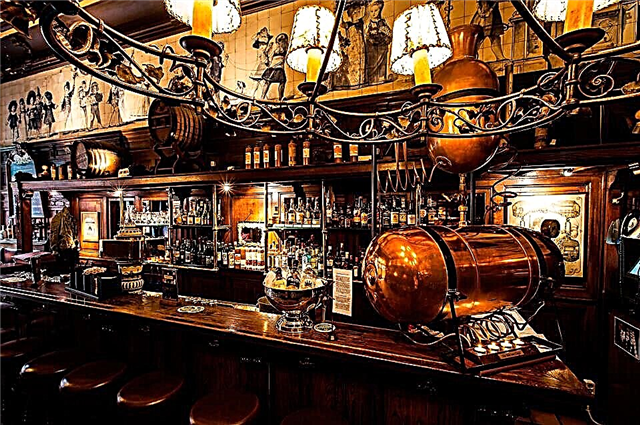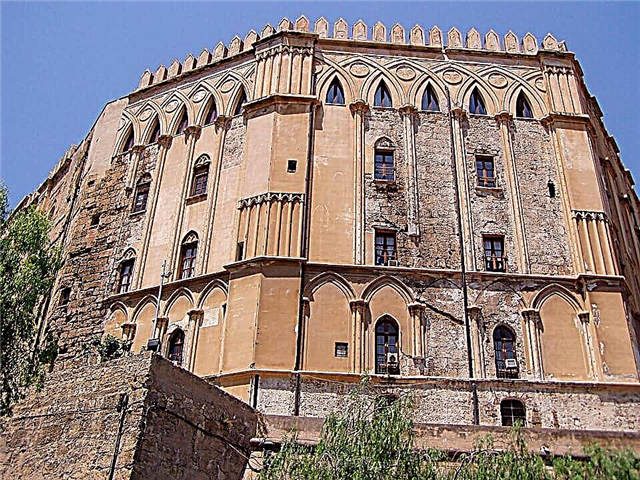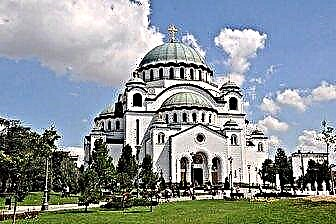Address: Russia, Moscow region, Sergiev Posad, Masliev street, 25
Based in 1783
Founder Archbishop Platon (Levshin)
Main attractions: gate bell tower (1874), Church of the Transfiguration
Coordinates: 56 ° 17'15.6 "N 38 ° 10'38.8" E
Content:
In the southeast of Sergiev Posad, about 4 km from the Lavra, there is an ancient Spaso-Bethany monastery, known as the Russian Bethany. Since the mid-1990s, it has been actively recovering. Pilgrims and tourists, visiting Sergiev Posad, try to be sure to visit this ancient monastery. Today, you can see the unusual Transfiguration Cathedral with the amazing stone Mount Tabor, the Spiritual Church and the beautiful Holy Gate with a high bell tower.
Construction of the Spaso-Bethany monastery and its history in the 18th and 19th centuries
In the 18th century, subordinate monasteries began to be created near the Trinity-Sergius Lavra, which accepted monks who wanted to lead a quieter and more secluded life than in the Lavra flooded with pilgrims. One of the first such monasteries was the Spaso-Bethany. Its founder is considered to be Archbishop Platon (Levshin), who was at that time the abbot of the Lavra.
Gate bell tower with the Holy Gates
The place for the monastery was Korbukha - the watershed between the Torgash River and a large pond, where fish were bred for the needs of the Lavra. Later he received the name Bethany. Before the construction of the railway embankment, the domes of the Trinity-Sergius monastery were clearly visible from the new monastery. The new desert was built from 1783 to 1787 in the form of a long rectangle stretching from east to west. They began to call it Bethany in memory of Palestinian Bethany - the place where the miraculous resurrection of Lazarus took place.
The construction project of the monastery was supervised by architects invited from Moscow, V.S. Yakovlev and N.M. Odoevtsev. On the central compositional axis were the Holy Gates, crowned with a bell tower, and the Transfiguration Cathedral. In addition, on the territory there were the house Spiritual Church, the house where Archimandrite Platon lived, four brotherly buildings and guest cells. The project also provided for a place for a necropolis, stables and a carriage shed. And the entire territory was surrounded by a stone fence.
In the year when all construction was completed, Plato was elevated to the rank of metropolitan. And from the Trinity Monastery to the newly built monastery, they transferred a particularly revered shrine - a wooden coffin, where the relics of St. Sergius of Radonezh were kept for almost two hundred years.
After the coronation ceremony (1797), Emperor Paul I passed through Sergiev Posad. He visited the Lavra and after that he paid a visit to the Bethany monastery. There he was received by Metropolitan Platon. Paul I was so pleased with the condition of the monastery that by his decrees he established a theological seminary in the monastery and secured significant land plots for the monastery. In addition, the monastery received income from three rental mills.
A special building was built for the seminary in 1800, and its grand opening took place on August 6. The new educational institution began to admit mainly young men from families of clergymen. Education could be obtained in one of three departments - grammatical and rhetorical, philosophical or theological. The Metropolitan carefully looked after the students of the seminary and monitored their food and living conditions. And the monastery itself even began to be called "school".
Transfiguration Cathedral
At the end of 1812, after the French troops retreated from Moscow and began to leave Russia, Metropolitan Platon completed his earthly journey, and his burial took place in the Transfiguration Cathedral. And the Theological Seminary, Plato's favorite brainchild, continued to develop. And in the monastery itself, several new stone buildings were built for novices, monks and abbots, as well as buildings for an almshouse and a hotel.
In the 60s of the XIX century, instead of the house Spiritual church, a large five-domed church with five thrones was erected in the monastery, which they began to call Tikhvin. At the beginning of the 20th century, the Spaso-Bethany Monastery enjoyed the same popularity among pilgrims as the Lavra and the Chernigov Skete.
The history of the monastery from the 20th century to the present
With the advent of Soviet power, the life of the monastery changed dramatically. Since 1918, the monks were allowed to stay in the monastery only in the status of a labor agricultural cooperative. But after 7 years, the monastery was still closed, although the monks lived in some of the premises until 1929. Most of the monastery buildings were given to an orphanage, and the building that belonged to Metropolitan Platon was transferred to a part of the exposition, which was owned by the city history and art museum.
In the early 30s of the last century, the territory of Bethany was given to a newly created poultry plant, and it became known as Pticegrad. The old buildings were not particularly spared. Some of them were dismantled due to dilapidation, and others - because of strong bricks. Thus, the Savior Transfiguration Church, the house that belonged to Metropolitan Plato, the monastery fence, the Holy Gates, the stone bell tower and the fraternal necropolis were destroyed.
The Tikhvin temple was beheaded and placed at the disposal of the local house of culture. It was used as an incubator, a dance floor and a cinema. A dermatovenerologic dispensary worked in the building of the seminary. Only rare surviving buildings reminded of the best days of the monastery in those days.
Spiritual Church
In 1998, part of the monastery buildings were transferred to the management of the Trinity-Sergius Lavra. And the difficult revival of the monastery began. The surviving buildings were repaired, and the lost ones were rebuilt. Restoration work at the monastery continues to this day. They use old photographs, a few surviving drawings, descriptions and sketches.
Temples and buildings of the Spaso-Bethany monastery
Today, the monastery is surrounded by a newly rebuilt fence with the Holy Gates, over which a stone bell tower is erected. This bright building, made in the pseudo-Russian style, has become a real decoration of the revived monastery ensemble.
The central place on the monastery territory is occupied by the newly erected Transfiguration Cathedral. The newly built temple has an oval shape and was rebuilt in the likeness of the cathedral that existed earlier. It has two thrones, the upper one is consecrated in honor of the Transfiguration of the Lord, and the lower one - for the glory of the miracle of Christ's resurrection of Lazarus. The unusual interior decoration, conceived by Plato, has been restored in the temple. The throne below is made in the altar. And the believers who have gathered in the temple for prayer see it as a small cave. According to legend, the bulk of Mount Tabor towered over the cave where Lazarus was buried.
In the Spaso-Preobrazhensky Church, a wall faced with marble in the likeness of a mountain rises to a semicircular upper throne. This wall is decorated with flowers, green plants and animal figurines. However, today much of what has been conceived remains only in the plans, since there are no funds for the construction of iconostases in the cathedral and the purchase of liturgical utensils.
By now, partial repairs have also been made, and divine services are being held in the Spiritual Church, and work continues on the restoration of the memorial building that belonged to Metropolitan Platon. The monument to the founder of the monastery was erected in 2012 near the monastery fence, not far from the newly built Holy Gate.
The current state and mode of operation of the Spaso-Bethany monastery
Today the Spaso-Bethany Monastery is active. He lives according to his strict charter. Since 2002, part of the territory belonging to him has been given over to the courtyard of the Trinity-Sergius Lavra. You can get to the monastery any day from 6.30 to 20.00.Morning services are held at 5.30 (Polunoshnitsa or Fraternal Prayer) and 6.30, and evening services - at 4.40. For the children of the parishioners, classes are held in the Sunday school.
Monument to the founder of the monastery, Metropolitan Platon
The monastery produces its own wine for worship and pilgrims. It also has its own small livestock farm, which supplies the monastery with milk and eggs.
How to get to the Spaso-Bethany monastery
The monastery is located in Sergiev Posad at the address - st. Masliev, 25. This place is located 3 km from the south of the Gethsemane Chernigov skete.
On their own. It is not difficult to walk from the railway station of Sergiev Posad to the territory of the monastery. To do this, first you need to move along the railway embankment towards Aleksandrov (to the north). At the second railway crossing - turn right onto st. Bethany. She and Pticegradskaya streets lead directly to the monastery walls.
By car. From Moscow you need to go along the Yaroslavl highway. Before reaching Sergiev Posad - turn right in the direction of Yaroslavl (M8 highway). Take this highway until you reach the sign “turn to Loza” and leave the road. Before reaching Loza, turn left and follow the main road to the monastery.
If you get through Sergiev Posad, then from the Troitsko-Sergievskaya Lavra from the Red Army street you need to turn right (east) onto the street. Karl Marx. Further along the Bethany and Ptitsegradskaya streets, drive to the territory of the monastery.











